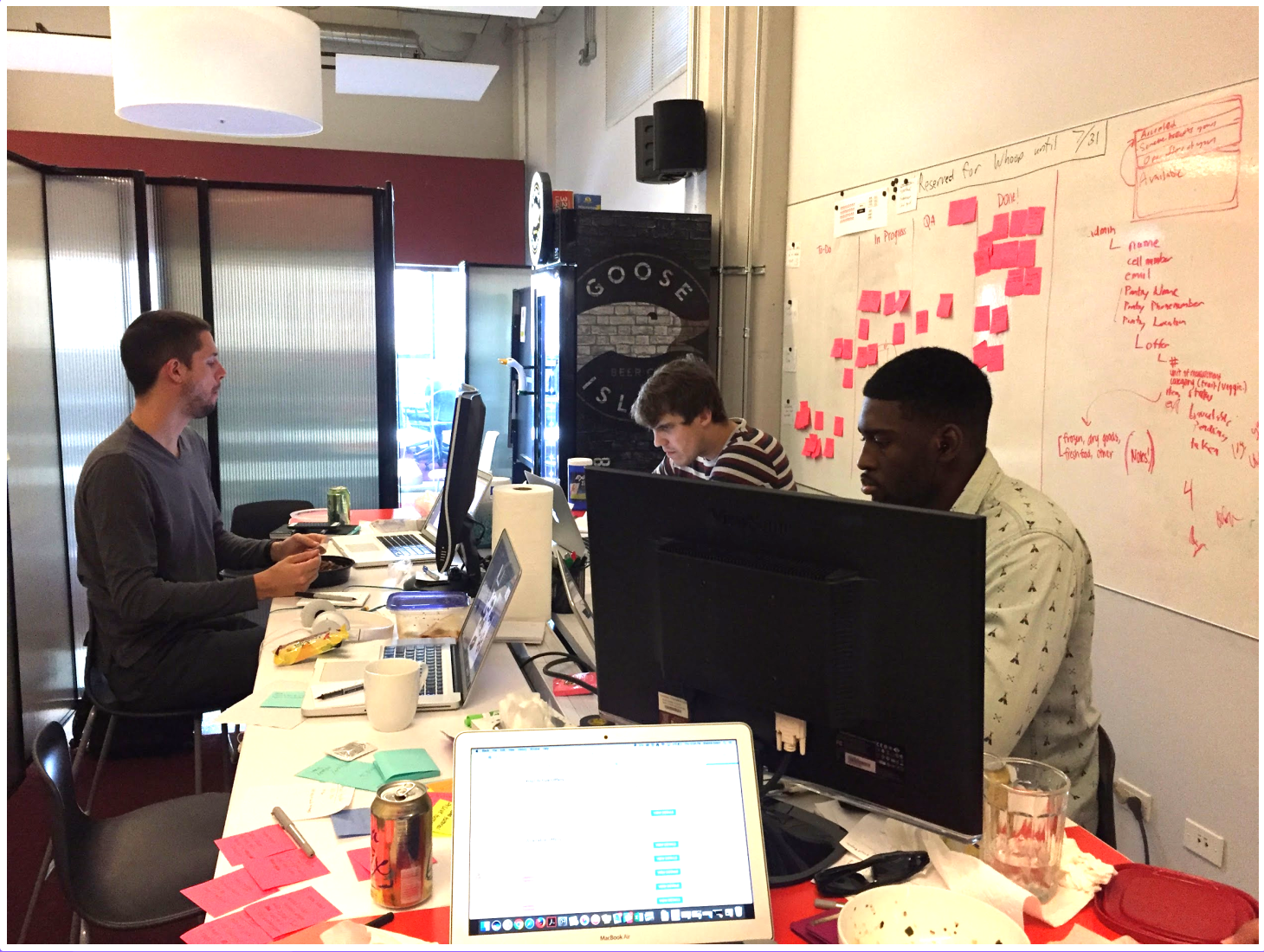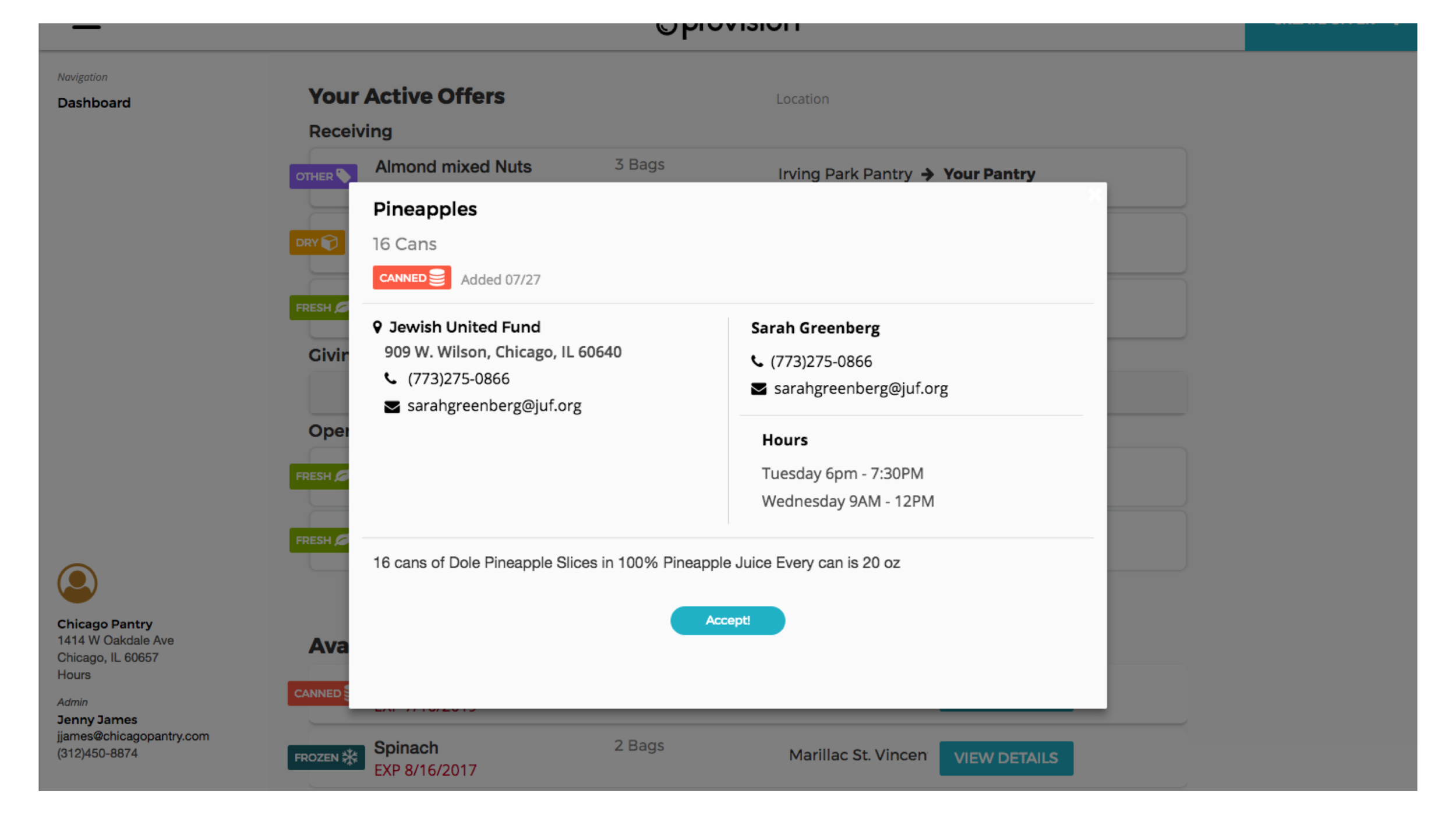Provision
Building a minimum viable product to help reduce waste locally by more effectively distributing food.
The ask
In two weeks, build a web app that helps food pantries.
The Problem
Food pantries can’t anticipate inventory fluctuations, which affects their ability to serve their local communities.
With unreliable suppliers and shifts in demand, the availability of fresh food, and the risk of waste can negatively impact the community in need.
The image on the right shows one of several bins that food pantries fill with spoiled food and throw away each day.
The Strategy
Make sure that food pantries always have enough of what they need by allowing one-to-one communication.
Introducing Provision
Provision is a network specifically designed to connect food pantries to help match the supply and demand of inventory across local food pantries.
Understanding Pantry Fluctuations
Food donation sizes and shipment times are inconsistent and can vary due to a pantry's hours of operation.
Food drives typically bring in one type of food (ex: canned food drive, peanut butter drive).
Some food pantries are located in communities that may have disproportionate amount of people with dietary specifications (ex: community with high number of diabetics).
UNDERSTANDING THE USER
Provision is intended to be used by food pantry administrators and volunteers alike.
Administrators
staffed either full-time or part time
Role Description - Need to Knows
Management of staff and volunteers
Food repackaging
Receiving of shipments
Driving for pick-ups and deliveries
Front-facing interactions with clients
Pain points
Inconsistent workloads from deliveries
Limited time to manage operations
Demand for food outweighs the supply
Volunteers
donate their free time to support the pantry
Role Description - Need to Knows
Shifts are typically 3 to 5 hours long
Include both returning and new volunteers
Report to the manager of volunteers
Tasks include food repackaging, managing shipments, and interacting with clients
Pain Points
Adaption to technology varies
Limited time to learn processes
Lack of food handling experience
We identified the following values for both administrators' and volunteers' involvement with food pantries:
Providing stability to families in the local community
Supporting the environment by helping to eliminate food waste
Enriching the lives of others by helping them make better food choices
Accommodating for the recent governmental cuts to support programs
Instilling values of generosity within their growing family
Brand Guidelines
We used our understanding of food pantries and our users to develop brand guidelines and to inform our executions.
Simplicity
Every element of our experience is purposeful and essential
Empathy
We understand the constant demands and pressures our users face
Collaboration
Everything we do maintains and enhances the fundamental element of teamwork
Sincerity
We make it a priority to show appreciation for our users during each stage of an assignment
Approachability
We are immediately inviting and easy to understand
Brand identity
the sprint
"No rotten strawberries" was the mantra for our two week sprint. Our objective was to make a minimum viable product (MVP) that would help eliminate the occurrence of spoiled strawberries from our local pantries. At the beginning of each day, we delivered a progress report to our scrum master, Eric Rolfsen, and identified which tasks were left to do, in progress, required testing, and done.
the result
We created a proposed user flow based on our user's jobs to be done to create the following prototype:
The login page serves as a starting point for all users.
The dashboard is organized in two categories:
active offers and available offers.
Food categories are featured in color-blocks: fresh, dry, frozen, canned and other. Expiration dates are prominently featured to indicate urgency.
The ticket form allows users to document what excess inventory they can share.
It includes quantity, food type, storage information and expiration date. It also gives information about the pantry posting the ticket.
The ticket form connects the dots through the path of least resistance by reducing confusion.
Opening the ticket gives more information about where the pantry is, when the food can be picked up and which person to talk to.
Users can call dibs on an offer by notifying the person who created the ticket and the rest of the network knows the offer has been claimed.
As part of the MVP, accepting a ticket does not remove it from the network, but helps initiate communication between both parties.
Closing a ticket frees up the dashboard for the pressing tickets that still need attention.
When a ticket is closed, it is filed in the archive under "Giving" to keep a record of which pantry has claimed the offer and is coming to pick it up.
The Team
the advisors
Andrea Dunn, Art Director
Victor King, Developer
Adam Senese, UX Designer
Danny Zilmer, Copywriter
Megan Rux, Content Writer
Ryan Paul, Project Management
Eric Rolfsen, Product Management
Mark Rowland, Client Engagement
Max Braun, Digital Strategy
Elizabeth Hancock, Strategy
Kim Price, Art Direction
Lisa Plachy, Copywriting
Erin Amico, Client Engagement
This project was produced during my summer internship at VSA Partners in Chicago, IL.
















